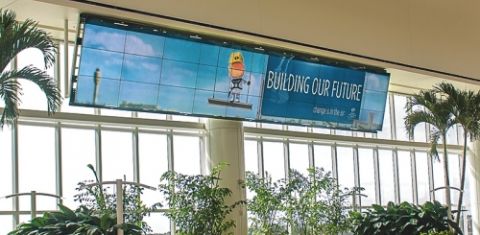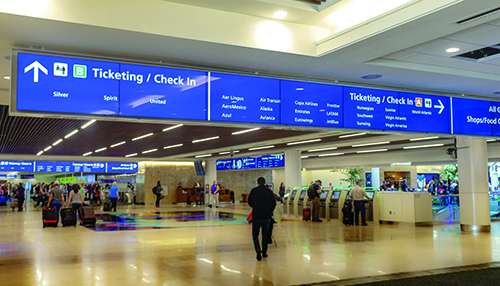Orlando Int’l Uses Digital Messaging to Enhance Passenger Experience

Have you met Annie the Astronaut? Can you spot Fred the Fish?
 Annie and Fred are just a couple of the creations that Orlando International Airport (MCO) presents to visitors on a digital ecosystem that so far includes 1,231 high-definition displays.
Annie and Fred are just a couple of the creations that Orlando International Airport (MCO) presents to visitors on a digital ecosystem that so far includes 1,231 high-definition displays.
The design concept, known internally as “The Orlando Experience,” is designed to engage, entertain and inform travelers. Chief Information Officer John Newsome notes that it also contributes to each of the top-level goals established by the Greater Orlando Aviation Authority: customer service, economic development, safe/secure facilities and fiscal responsibility.
|
facts&figures Project: Largescale Digital Display Location: Orlando (FL) Int’l Airport
Display Size: 1,231 individual screens viewed
Project Management & Installation: Software & Creative Content: Synect Display Mfg: LG Electronics USA Total Resolution: 1,329,480 by 1,920 pixels
Primary Goals: Entertain & inform customers; |
Built for 24 million annual passengers, MCO is currently pushing 47 million, reports Scott Goodwin, assistant director of airport operations. The extra passenger volume and an ongoing $4.27 billion capital improvement program keep airport officials exploring new ways to maximize existing facilities. As Goodwin explains it, the challenge is to create memorable experiences, even when the airport is crowded.
Travelers have options, adds Rod Johnson, assistant director of public affairs. Offering “The Orlando Experience” encourages them to choose MCO, he explains. Johnson also cites the program as one of the many reasons MCO earned the top customer satisfaction ranking for mega airports in the 2017 and 2018 J.D. Power North America Satisfaction Studies.
Digital Canvas
“The Orlando Experience” is presented on matrices of narrow-bezel monitors that display high-definition, full-motion video content. Viewed as one large display that stretches more than 10,000 square feet, the total resolution would be 1,329,480 pixels by 1,920 pixels.
The information and entertainment presented varies according to location. A “continuous flow” allows MCO to manage the customer experience from check-in, through the security checkpoints and, ultimately, throughout the facility, Goodwin explains.
About 700 screens located behind the check-in counters allow the airport to assign positions based on actual airline operations. This flexibility optimizes the use of resources without loss of airline branding. As MCO evolves toward a common-use platform, the technology will allow the airport to operate more dynamically to support its airlines, notes Goodwin.
 Content can be changed frequently, and nearly in real-time. For example, if a diversion causes a carrier to need additional check-in counters, MCO can expand the airline’s brand and space within seconds. “With common use, we have the flexibility with the push of a button to expand and contract as needed,” Goodwin advises.
Content can be changed frequently, and nearly in real-time. For example, if a diversion causes a carrier to need additional check-in counters, MCO can expand the airline’s brand and space within seconds. “With common use, we have the flexibility with the push of a button to expand and contract as needed,” Goodwin advises.
Information for travelers such as flight departure times, checkpoint wait times and promotional videos can also be displayed on the digital canvas. When airlines are not using the counters, the backwalls feature community information and entertainment or games such as Fred the Fish.
At the security checkpoints, digital content includes the gates served at that checkpoint, dynamic estimated wait times and TSA requirements. Directional signs guide travelers with information about the location of airline counters, departure gates, TSA checkpoints, bag claims, elevators, and more.
Full-motion video capabilities allow movement of icons such as arrows and the animated Annie the Astronaut to capture the attention of travelers. Many of the signs are “smart,” so content can be tailored to the audience based on the season, time of day or location. For example, a display near an arrival from Brazil could include messages in Portuguese.
“The content is developed to include not just the information needed for a specific location, but also for enjoyment of our travelers and to instill a sense of place that is consistent with ‘The Orlando Experience’—a calm, comfortable environment that blends air and light, water and foliage, and art,” Newsome explains.
MCO wants to create memorable experiences that make visitors want to return and talk glowingly on social media, adds Goodwin.

Toward that end, the airport’s Find Fred the Fish game encourages travelers to hunt for a friendly aquatic creature in various scenes depicted on digital displays throughout the facility. A digital, animated take on Where’s Waldo, the game is designed to entertain passengers and take their minds off long lines or wait times that might exist.
Annie the Astronaut is becoming MCO’s ambassador, Goodwin reports. The plan is to grow the character and create scenes where Annie demonstrates different tasks, such as divesting and moving through the TSA checkpoint.
Creative Collaboration
The airport contracted Synect, a visual communications company, to provide software, integration, support and creative services. “It’s a common effort,” Goodwin says. The airport provided the vision and parameters; Synect leveraged its creativity to develop content.
Yahav Ran, the company’s chief executive officer and founder, notes that airport officials wanted the digital content to be informative and fun for travelers. “That was the main goal, and I believe we achieved it together—and then took it up quite a few notches from an innovation perspective and capability,” he relates.
 Airport officials were clear that they did not want content to look cheap or contain advertisements, Ran adds. Keeping the look and feel of the new digital material on par with the existing spirit of MCO was key, he notes.
Airport officials were clear that they did not want content to look cheap or contain advertisements, Ran adds. Keeping the look and feel of the new digital material on par with the existing spirit of MCO was key, he notes.
“It is important to make our travelers feel comfortable, safe and well informed to ease and speed their journey; to remind them what Orlando has to offer; and to entertain them,” Newsome explains.
Working closely with MCO and conducting its own research, Synect developed digital content to align with the airport’s diverse passenger demographics. “We had a chance to really learn about the specific Orlando experience,” Ran explains. Observing passengers and noting details about their wardrobe, luggage and behaviors helped Synect develop a comprehensive picture of the people that travel through MCO.
A four-month pilot program using about eight displays proved helpful for the creative process. “It gave us the ability to test what would work and what wouldn’t, and was a very successful element before going to the bigger project,” reflects Ran.
When developing content, the team considered numerous concepts. It also tested animation speed, display size and color use to ensure that content was readable, but not too bright or nauseating. “We went through a lot of different sketches and story boards with airport staff to make sure what would be the most successful, given what they know of the passengers and what they’ve seen,” explains Ryan Boyle, creative director at Synect.
 Creative personnel made about 50 revisions when creating Annie the Astronaut. “It was the same with all the other characters and experiences,” says Boyle, explaining that team members constantly assessed whether an image or look would represent the airport well and make passengers feel comfortable. “It’s definitely been a partnership,” he reflects.
Creative personnel made about 50 revisions when creating Annie the Astronaut. “It was the same with all the other characters and experiences,” says Boyle, explaining that team members constantly assessed whether an image or look would represent the airport well and make passengers feel comfortable. “It’s definitely been a partnership,” he reflects.
Before any content is presented to the public, it must first pass through two separate review groups: one for brainstorming, review and guideline-compliance and another at the executive level.
Rather than requiring 24/7 operator control, Synect’s system is largely autonomous. It also allows complex playback of imagery, video and dynamic HTML5 content or a blend of all because of its seamless integration with MCO’s airport operations database, notes Ran. “It knows which airlines are supposed to be where and how big the canvas behind it will be,” he explains. “The system is ready with specific content and scenarios, and can dynamically change by itself based on the input that is injected.”
Airline Branding
In addition to developing content for the airport, Synect worked with MCO’s airlines, each with its own brand guidelines, logo and colors. Ran says it was a challenge to create a single canvas that blended with the airport atmosphere and also allowed each airline to have its own look, feel and experience.
Synect helped each carrier’s marketing team navigate the process of executing its own brand on the digital platform. Under their lease agreements with the airport authority, airlines receive a base package of branding for their functions, but they can independently contract with Synect to “jazz it up,” says Goodwin.
That said, there are standards and guidelines the airlines must follow, and MCO has final say over the look and feel of all content. “We don’t want one carrier’s logo to be 4 feet wide next to another that is 1-foot wide,” explains Goodwin. The airport also wants to keep the digital canvas from becoming an overly commercial platform with flashy lights or too much movement. “We’re looking to ease the anxiety and stress that people may associate with travel and keep it pretty calming,” he remarks.

The layout of the digital canvas has a unique aspect ratio—it’s not like a typical display on a mobile phone, tablet or television. As a result, content must be carefully crafted to display correctly on the screens, but also be flexible to change. For example, if an airline needs to expand its footprint by adding additional check-in counters, the branding information must be adaptable to new locations.
Digital displays allow the airlines to go beyond the limits of traditional printed material. “They can engage with passengers…have some motion and make a really big impact,” Boyle comments. Moreover, if airlines rebrand or the airport changes carriers, digital material can be adjusted more quickly than print.
Although the airport anticipated some resistance to changing the dated 3D branding on walls behind the check-in counters, Goodwin reports that airlines are enjoying the benefits of the new, more dynamic operating environment.
Visual Landscape
Operating capabilities and logistics were carefully considered, including display size, reflective lighting, viewing distances/angles, display lifespan and hardware requirements.
The design of content is specifically adapted for different touchpoints throughout the passenger journey. “Touch and go” is the strategy for curbside areas, because travelers need quick but thorough information. Content is brief, bold and crafted to focus passengers’ attention on what they need to do next, explains Ran.
Inside the check-in area, backwall airline branding and videos of Orlando scenery are designed to provide a soothing atmosphere. Digital wayfinding guides travelers to the next steps of their journey.
Characters and graphic icons add to the wayfinding experience in ways that printed material can’t, Boyle observes. Motion can subconsciously guide people to where they need to go, while also reducing potential stress, he explains.
“Annie can nudge and point you in the right direction,” adds Johnson. “It all goes back to the overarching philosophy of The Orlando Experience, which is about putting the customer first and ensuring that passengers have the best possible experience. Enhancing wayfinding was one of the key points,”
Boyle describes the content as exciting and engaging. “It feels like you’re going on an adventure or journey,” he remarks.
Another opportunity the system affords is the ability to create facility-wide campaigns. For example, the airport celebrated Independence Day by showing subtle fireworks and patriotic elements on its digital displays—without distracting from the core information being presented, notes Boyle.
Synect even incorporated Annie the Astronaut into patriotic scenes. “The entire airport felt like it was themed…It was 4th of July everywhere,” he remarks. “The idea is to make sure it works together as a whole, throughout the entire airport ecosystem.”
Going forward, the airport plans to have similar campaigns for other holidays and seasons.
Cost/Benefit Analysis
When games like Find Fred the Fish are displayed on monitors, adults and children alike point and play along. “They are smiling and happy,” Boyle reports. “Sometimes, the line backs up because people aren’t paying attention to the line—they’re having these moments, these experiences of being entertained. Anything that can help make the experience a little bit less chaotic is good for the passengers.”
Online feedback is similarly positive. “The cool thing is people are taking pictures in front of these large displays and posting them on social media,” he adds.
Because the digital displays were installed in the midst of a major refurbishment, airport officials say it is difficult to quantify specific project costs. In a similar vein, it is also difficult to measure the concession revenue that might be lost from confused or frustrated passengers, notes Goodwin. “There’s an investment, but if we’re getting rewards, recognition and efficiencies, there’s definitely a payback we’re benefiting from,” he comments.
Looking Ahead
In early October, infrastructure upgrades were nearly complete; and all ticket counter backwalls were slated to transition to the new digital platform. Goodwin reports that wayfinding will be upgraded to digital “where it makes sense,” and the airport will continue deploying themed content to engage and entertain travelers. “For the most part, the future is about the content and getting creative,” he notes.
The digital ecosystem is being extended to the South Terminal C Complex now under construction, and additional elements and refinements are in process for terminals A and B in the existing North Terminal Complex.
Other potential uses for the system include redirecting customers around construction or crowd control at security checkpoints. “We could adjust to the dynamic environment of human behavior by communicating to them through the signage,” he explains.
Ran notes that the digital displays provide the airport with added flexibility to react very quickly to a variety of operational situations.
Airport-Wide Digital Messaging
|
2022 Charlotte Douglas International Airport Report of Achievement
 Giving back to the community is central to what Charlotte Douglas International Airport and its operator, the City of Charlotte Aviation Department, is about, and last year was no different.
Giving back to the community is central to what Charlotte Douglas International Airport and its operator, the City of Charlotte Aviation Department, is about, and last year was no different.
Throughout 2022, while recovering from the COVID-19 pandemic, we continued our efforts to have a positive impact on the Charlotte community. Of particular note, we spent the year sharing stories of how Connections Don't Just Happen at the Terminal - from creating homeownership and employment opportunities to supporting economic growth through small-business development and offering outreach programs to help residents understand the Airport better.
This whitepaper highlights the construction projects, initiatives, programs and events that validate Charlotte Douglas as a premier airport.
Download the whitepaper: 2022 Charlotte Douglas International Airport Report of Achievement.








